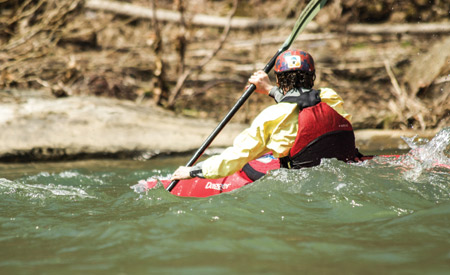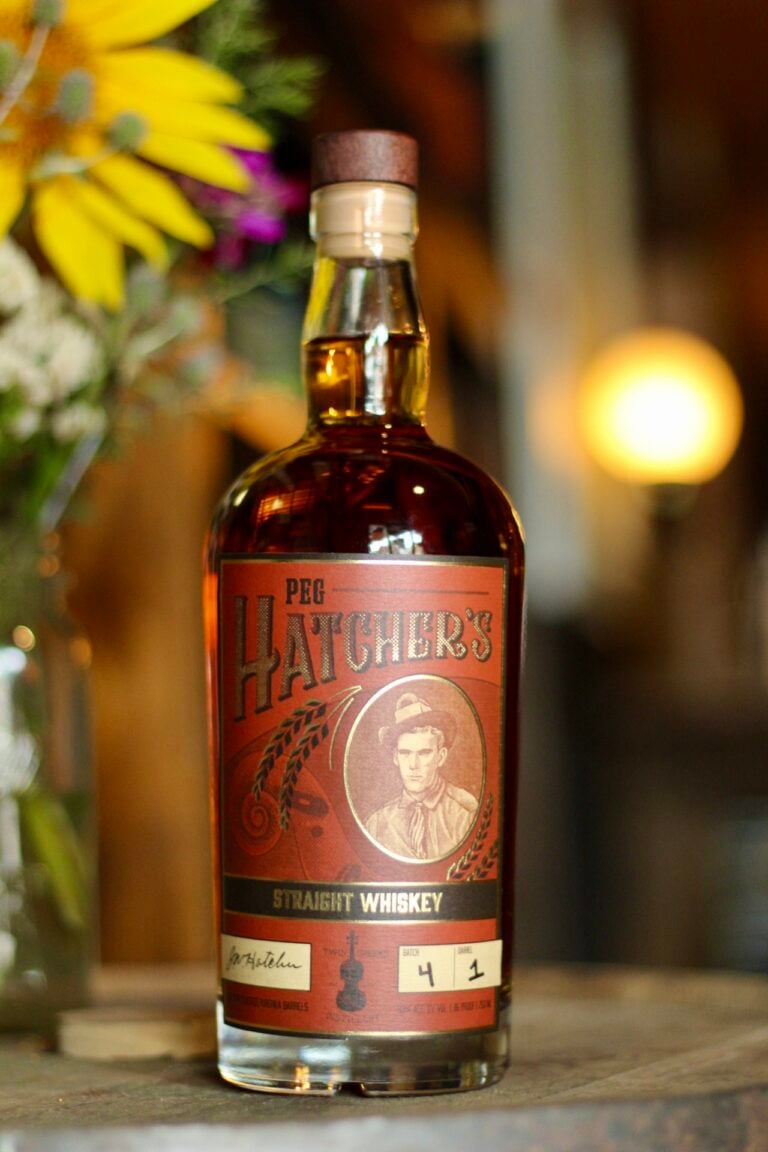Nestled among the rugged Laurel Highlands of Pennsylvania lies an old logging town with an international renown that far outweighs its scant population of 59.
That town is Ohiopyle, a sleepy little place with a few old buildings and one main road that runs through town uninterrupted by stop sign or traffic light. But what it lacks in appearances it makes up for in one thing. Whitewater.
Picture this: a one-mile class III “Loop” on the Lower Youghiogheny (Yough) in your front yard, the natural bend of the river making a shuttle unnecessary; a half-hour-drive to the put-in of the class IV+ Upper Yough; another 45-minute drive to any of the Yough’s steep class V tributaries along with countless other runs in the area like Big Sandy and the Cheat River Canyon; and, of course, a killer Thursday night yoga class by Yogi Wade paired with brews, foods, and tunes at the local Falls City Pub. That sleepy little town doesn’t seem so drowsy anymore, right?
It’s a diamond in the rough no doubt, yet one whose reputation for world-class whitewater, and whitewater paddlers, is incomparable. Rewind 30-some years to the late ‘70s and ‘80s, to an era that saw the rebirthing of whitewater paddling and a boom in the industry right on the waters of the Yough. Whether raft guide, entrepreneur, or downright gutsy kayaker, you can’t tell the history of paddling in the ‘Pyle without mentioning the following five individuals.
ERIC MARTIN
Owner •Wilderness Voyageurs
Eric Martin never anticipated taking over the family rafting business. His father, Lance Martin, had started one of the first rafting companies in Ohiopyle, Wilderness Voyageurs, with his wife in 1964. Although Martin worked for his parents during the season, in his eyes, that job was merely a means to an end.
“I worked as a raft guide to earn money to go kayaking somewhere else,” Martin says. “I was on the water twice a day, every day, year-round.”
Inspired by other world-class kayakers like Jon Lugbill and Kent Ford who also frequented the Yough, Martin took his passion for paddling to a competitive level. In 1983, he began slalom racing and would continue to do so for over a decade, placing second in the junior world championships and making it all the way to the team trials for the Olympic games in 1996.
“There were no boat companies sponsoring athletes in the ‘70s and ‘80s,” Martin recalls, “but when you’re talking and paddling with U.S. team members who are traveling around the world going kayaking, that seems like a pretty good idea at 14 years old.”
But, as life would have it, the year 1991 saw a turn of events that sent Martin from his competitive tour around the world back to his hometown to take over Wilderness Voyageurs. Martin has kept the business going strong and the company is celebrating its 50th anniversary this year, making it the oldest rafting outfitter in the East. Although Martin no longer has the flexibility to get out on the water “twice a day, every day, year round,” the outfitter is conveniently located across the train tracks from the Lower Yough take-out.
“We’re in the crucible of whitewater in this country,” Martin says. “Whether it’s a flatwater workout or ramping it up and running class Vs, it’s all available. That’s a lot of quality of life right there.”
KARA WELD
Co-owner •Immersion Research
Although Kara Weld grew up on the banks of the Yough, she was born and raised not in Ohiopyle but in Confluence, just a short 30-minute drive over the mountain. Her father was an avid outdoorsman, and together, the two learned to kayak.
“We were the biggest geeks on the river,” Weld remembers. “I’m pretty sure I had a big football helmet on.”
As Weld grew older, so too did her love of kayaking. Although Ohiopyle had a crew of older guys who paddled daily, Weld was just a kid still. More than that, Weld was a girl, and women paddlers in the ‘80s were far and few between. When a new kayaking school opened in town and the owner started a kid’s group, Weld immediately signed up. In less than a year, she was racing at her first slalom event.
From the Lower Yough to the Ocoee River, Weld was on the water nearly every weekend, either training or competing. In 1984, Weld earned a spot on the U.S. junior team, which launched her kayaking career. Suddenly she was no longer dinking around on the Middle Yough with her dad and her beater gear; she was paddling some of the most difficult runs in the world.
“I think I swam in every country I visited,” Weld says. “I was very timid in harder whitewater.”
Keep in mind that Weld was just a teenager at the time. Eventually, she would move up the ranks, becoming a three-time U.S. National Women’s Champion who competed on the U.S. team for 20 years. In 1995 she married her husband John and two years later, made the decision to quit the competition scene. That same year, Weld returned to her hometown of Confluence to embark on a new adventure.
“My husband said, ‘We should make kayaking gear.’ I told him, ‘You’re insane.’”
Thus Immersion Research (IR) was born, a kayaking gear manufacturer based out of Confluence that made its splash onto the marketplace by making rash guards and surf trunks, the labor taking place in the Weld family basement. Now, IR produces everything from base layers to dry suits, a staple brand among Ohiopyle’s many raft guides and paddlers.
JESS WHITTEMORE
Chief engineer • Immersion Research
“It was like a renaissance of kayaking.”
That’s how Jess Whittemore describes the whitewater scene in Ohiopyle during the late ‘70s and early ‘80s, a time of change and innovation, when awkwardly long composite boats were the industry standard and the slickest, sickest moves entailed twirling your paddle around your neck. For Whittemore, who moved to the area from Albright, W.Va., to raft guide for another outfitter in town, the ‘80s in particular brought about one of the greatest changes of all, a development he was largely responsible for: the introduction of three-dimensional boating.
“I discovered pillow squirting and blasting holes and it really revolutionized the sport,” Whittemore says. “It eventually turned into present-day play boating and it’s fantastic what they’re doing now, things I never dreamed of.”
With fellow paddler and friend Jon Lugbill, Whittemore continued to challenge himself to invent different moves. As he continued to push, he began to tap into the currents that not only flow on the water’s surface but also beneath and around the features. In opening up this entirely unexplored realm of possibilities, Whittemore realized that the boat styles at that time could not perform the moves he knew were possible.
“I designed my first kayak right there in the garage,” Whittemore says. “I called it the Millennium Falcon. It was the first squirt boat really, although I didn’t know it then.”
Whittemore was one of a few other paddlers in town who were beginning to design their own boats, the most prominent of those being Jim Snyder who began specifically crafting squirt boats. Whittemore continued to build boats throughout his paddling career, working in the shop when he wasn’t on the water.
“I was the quintessential kayak bum,” he says. “I was so busy barely making money by making boats that my full and complete attention was really just to be a great kayaker.”
Whittemore eventually took his creative outlet to Immersion Research where he continues to work as the chief engineer. He designs everything from dry tops to spray skirts, and although his paddling heyday has simmered down a bit, he remains active in the paddling community by fighting for recreational boating dam releases in the area.
PHIL COLEMAN
Raft guide • Wilderness Voyageurs
Although the commercial rafting scene in Ohiopyle mostly centers on running the Yough and the nearby Cheat River Canyon, a select few of the area’s boaters in the late 1970s were hungry for more. Phil Coleman was at the forefront of that group, a raft guide by day and kayaker by night.
“There were a lot of egos flying around back then,” Coleman says. “The highest concentration of kayakers pushing the envelope in the late ‘70s and early ‘80s were located in Ohiopyle. The sport was going through a true revolution.”
Like most paddlers in town, Coleman was on the water nearly every day and had been raft guiding for the local outfitters since high school. He joined names like Dean Tomko, Roger Zbel, and the Snyder brothers on the water, and soon Coleman was part of an elite paddling posse that was running some of the steepest creeks around. In 1978, Coleman, accompanied by Jim Snyder and Mike Fentress, set a record in the paddling community, knocking off a first descent of the infamous Quarry Run.
“There were lots of smash ups and pins and broken boats and near close calls, but that was definitely one of my greater accomplishments at the time,” Coleman says, failing to mention that he was the near close call. Now, over 30 years since that record-setting first descent, Coleman is still an active boater and member of the paddling community.
“Maybe something’s wrong with me, but I love it. It’s just plain fun,” he says.
Coleman splits his time between Albright, W.Va., Ohiopyle, Penn., and Costa Rica so that he can be on or around the water year-round. In Costa Rica, he started his own eco-tourism adventure outfitter called RainForest World and regularly guides tourists down everything from class IV+ whitewater to scenic float trips.
TOM LOVE
Owner • Airtight Inflatables
If you don’t know who Tom Love is, you’ve likely seen boaters taking his brainchild down rivers around the world, or maybe you even own one yourself. The shredder, an inflatable river craft, was one of those inventions that came out of that whitewater renaissance of the ‘80s. Prior to crafting the shredder, Love had not only been an avid paddler and raft guide, but also a boat repairman.
“For awhile, every company that built boats had me as their warranty center,” Love says. “Finally I said, ‘Well gee whiz, these people are building screwed-up boats. I can screw up boats just as easy as they can.’”
In 1978, Love quit the business of repairing other companies’ boats to focus his energy on crafting his own line of inflatable rafts. Already an iconic figure in the rafting industry around Ohiopyle, Love was easily able to strike deals with local outfitters and made just enough money to continue experimenting with boat designs while supporting himself. The idea for the shredder came about in the mid-1980s when a friend of Love came to him with a request. He needed a boat that was faster than traditional rafts so he could get ahead of commercial trips and shoot video, the early predecessor of a video boater.
“If not for huge video cameras, these shredders would have never been built,” Love says.
That first prototype looks much like the present-day shredder, and it wasn’t long before Love abandoned producing traditional oval rafts to exclusively making shredders.
“For a while I was only making demos, but I kept selling the sons-o’-bitches,” he says, a testament to the cutting-edge-inflatable’s increasing popularity. Since then, other raft manufacturing companies have tried their hand at producing similar crafts; however, Love’s base in Ohiopyle and his connections in the region ensure that the shredder craze will live on.








